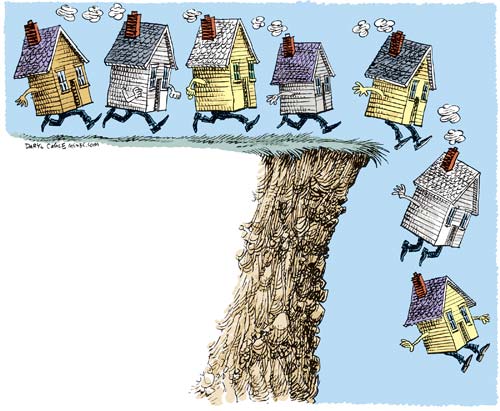The IMF just released its world economic outlook, including this update on the generally dismal prospects for real estate markets across the globe.
Real estate markets have been a source of strength during past recoveries, but this time is different. In many major economies around the globe, house prices continue to fall or are only gradually stabilizing. In a few countries, including the United States, there are concerns of a “double dip” in the housing market.
The econometric model that we have used in past analyses suggests that real house prices in advanced economies could fall at an annual rate of between 0.5 percent and 1.5 percent. This is under the assumption that the remaining correction in house prices takes place over the next five years.
The shedding of debt by households could make the macroeconomic impact of this housing bust greater than that of past busts. Households shed debt at a much slower pace than the corporate and financial sectors. This is because the largest portion of household balance sheets on both the asset and the liability side tends to be real estate, which is more difficult to sell off in a fire-sale than bonds and equities. Therefore, the recovery is likely to be slower than in recessions triggered by problems in corporate balance sheets.
For countries such as Spain and Ireland there is an additional reason to expect slow recovery. In these countries, the construction sector grew disproportionately to other sectors of the economy and became the engine of growth in these economies. The housing bust thus brought severe contraction in construction output and employment. The unemployment rate is now three times its 2000–07 average in Ireland and twice its 2000–07 average in Spain, compared with a 20 percent increase on average among euro area countries.
“Double dip” in U.S. housing markets?
In the United States, tax measures temporarily increased housing activity, but demand fell and prices receded after the recent expiration of these incentives. Given the limited success of mortgage modification programs and the shadow inventory from foreclosures and delinquencies, this has renewed fears of a “double dip” in real estate markets.
How large is the shadow inventory? Adding together (i) homes already in foreclosure; (ii) those at risk of foreclosure because they have been in default for 60 days or more; (iii) predicted re-default on modified loans and possible strategic defaults if house prices decline, the shadow inventory of houses for sale may reach 7 million. This is ten times the historical absorption rate of 700,000 units a year overall in the U.S. housing market.
The problem is compounded because, in this recession, U.S. states where the house price bust was more pronounced are also where unemployment has increased the most. This relationship likely reflects the importance of the construction sector in these states’ economies as well as lower labor mobility resulting from problems in the housing sector.
There are other threats. Delinquency rates on commercial mortgage-backed securities have recently reached record highs, and considerable amounts of commercial real estate debt will become due over the next few years. And resets on adjustable-rate loans loom on the horizon.
Rebound in Asia-Pacific?
Several economies in the Asia-Pacific region, Canada, and most Scandinavian countries have experienced a rebound in real estate prices and residential investment since 2009. Will this rebound continue?
In many of the advanced economies in this group, current price-to-rent and price-to-income ratios are still above historical averages, and econometric estimates still show a deviation of house prices from fundamental values.
For the emerging market economies in this group (namely, China, Hong Kong SAR, and Singapore), fundamentals appear to provide more support for the observed house price increases, mainly due to strong growth prospects. But the econometric estimates are less reliable for these economies than for the advanced economies because data are available for only a fairly short period. More anecdotal evidence—reports of speculative activity, rising vacancy rates in commercial property, sizable mortgage credit growth, and massive capital inflows, especially in China—suggest that these real estate markets may be overheating. In China, deviation of house prices from fundamentals is estimated to be higher in Beijing, Nanjing, Shanghai, and Shenzhen than in other cities.
Some governments in the region have taken measures to tame real estate markets. The Chinese government deployed a range of regulatory tools in the spring of 2010, including increases in transaction taxes and stricter controls on lending.
Summary
In contrast to past recoveries, there appears to be little hope for a sustained upside boost to the overall economy from the real estate sector. In economies where real estate markets are still in decline, the drag on real activity will continue. And in economies where house prices and residential investment are rebounding, concern about bubbles is eliciting policy actions that will temper any short-term boost to economic activity.






